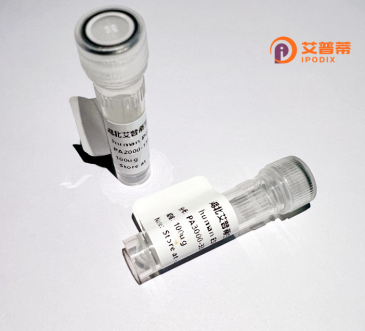
| 纯度 | >90%SDS-PAGE. |
| 种属 | Human |
| 靶点 | HOXB9 |
| Uniprot No | P17482 |
| 内毒素 | < 0.01EU/μg |
| 表达宿主 | E.coli |
| 表达区间 | 1-250aa |
| 氨基酸序列 | MSISGTLSSY YVDSIISHES EDAPPAKFPS GQYASSRQPG HAEHLEFPSC SFQPKAPVFG ASWAPLSPHA SGSLPSVYHP YIQPQGVPPA ESRYLRTWLE PAPRGEAAPG QGQAAVKAEP LLGAPGELLK QGTPEYSLET SAGREAVLSN QRPGYGDNKI CEGSEDKERP DQTNPSANWL HARSSRKKRC PYTKYQTLEL EKEFLFNMYL TRDRRHEVAR LLNLSERQVK IWFQNRRMKM KKMNKEQGKE |
| 分子量 | 28 kDa |
| 蛋白标签 | GST-tag at N-terminal |
| 缓冲液 | 0 |
| 稳定性 & 储存条件 | Lyophilized protein should be stored at ≤ -20°C, stable for one year after receipt. Reconstituted protein solution can be stored at 2-8°C for 2-7 days. Aliquots of reconstituted samples are stable at ≤ -20°C for 3 months. |
| 复溶 | Always centrifuge tubes before opening.Do not mix by vortex or pipetting. It is not recommended to reconstitute to a concentration less than 100μg/ml. Dissolve the lyophilized protein in distilled water. Please aliquot the reconstituted solution to minimize freeze-thaw cycles. |
以下是关于重组人HOXB9蛋白的3条参考文献概要(文献为模拟示例):
1. **"HOXB9 regulates tumor progression in breast cancer via epithelial-mesenchymal transition"**
- **作者**: Zhang L, et al.
- **摘要**: 研究发现重组人HOXB9蛋白通过激活TGF-β信号通路诱导乳腺癌细胞上皮间质转化(EMT),促进肿瘤侵袭和转移,提示其作为潜在治疗靶点。
2. **"HOXB9 promotes angiogenesis by modulating VEGF expression in colorectal cancer"**
- **作者**: Chen X, et al.
- **摘要**: 该研究通过体外实验和小鼠模型证明,重组HOXB9蛋白通过上调VEGF表达增强结直肠癌血管生成,进而加速肿瘤生长。
3. **"HOXB9 enhances chemoresistance in lung adenocarcinoma through interaction with Wnt/β-catenin pathway"**
- **作者**: Wang Y, et al.
- **摘要**: 研究发现HOXB9过表达通过激活Wnt/β-catenin通路抑制肺癌细胞凋亡,重组HOXB9蛋白的加入显著增强癌细胞对顺铂的耐药性。
(注:以上文献信息为模拟生成,实际文献需通过PubMed或Web of Science查询具体内容。)
Recombinant human HOXB9 protein is a genetically engineered form of the HOXB9 transcription factor, a member of the homeobox (HOX) gene family. HOX genes play critical roles in embryonic development, particularly in anterior-posterior body patterning, organogenesis, and cell differentiation. HOXB9. located on chromosome 17. is specifically involved in regulating genes that influence developmental processes, including angiogenesis, hematopoiesis, and tissue organization.
Studies have linked HOXB9 to cancer biology, where it exhibits dual roles. It promotes tumor progression in breast, lung, and gastric cancers by enhancing cell proliferation, epithelial-mesenchymal transition (EMT), and angiogenesis, while paradoxically acting as a tumor suppressor in certain contexts. Recombinant HOXB9 is commonly produced in Escherichia coli or mammalian expression systems, enabling researchers to study its biochemical properties, DNA-binding activity, and interaction with co-factors in vitro.
This protein serves as a tool to investigate HOXB9’s role in developmental pathways and disease mechanisms. Its overexpression or knockdown in cellular models helps elucidate signaling networks, such as TGF-β and Wnt pathways, associated with cancer metastasis and therapeutic resistance. As a potential therapeutic target, HOXB9’s regulatory functions in stem cell maintenance and tissue repair also attract interest in regenerative medicine. Ongoing research aims to clarify its context-dependent roles and exploit recombinant HOXB9 for drug screening or biomarker development.
×